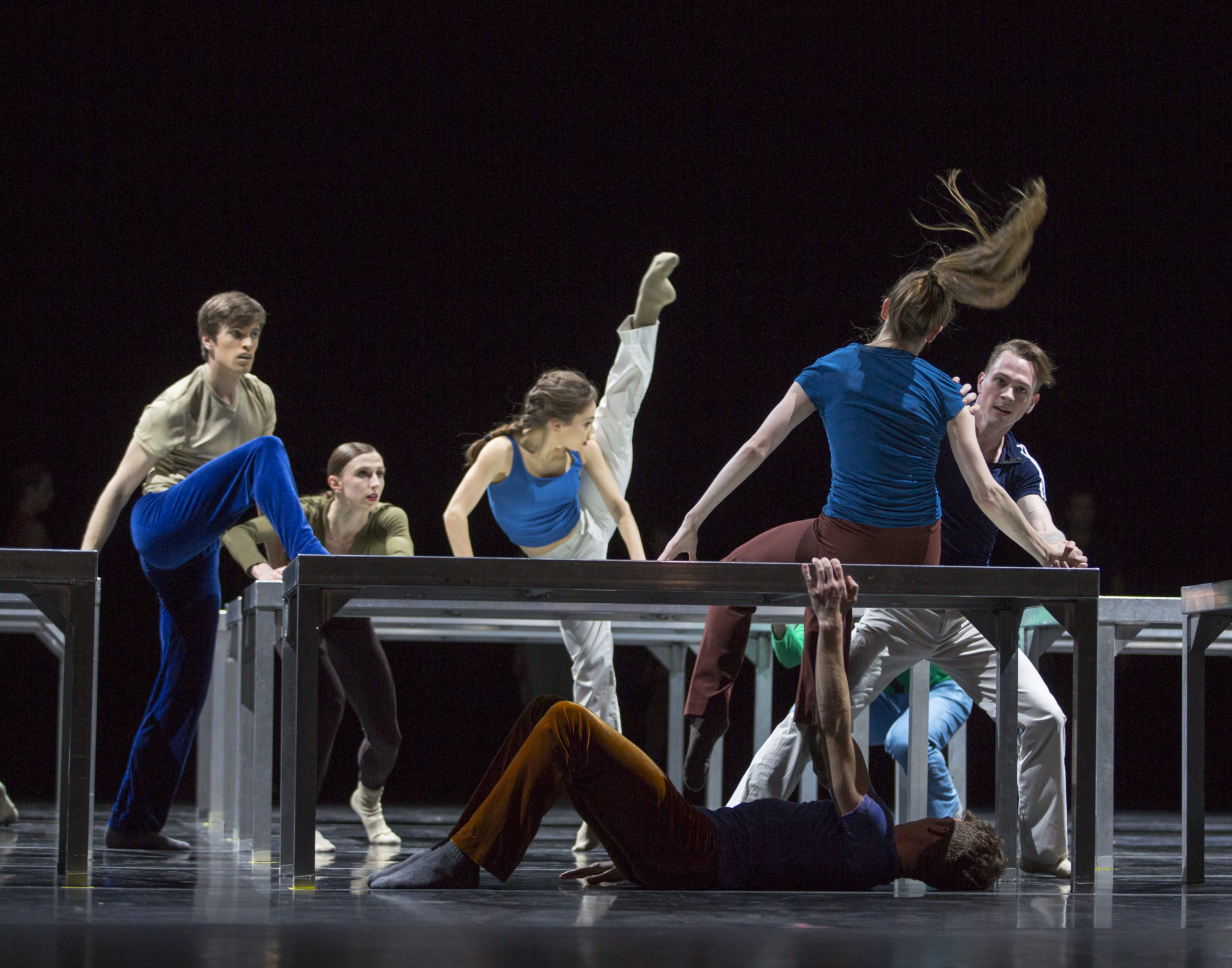
Pacific Northwest Ballet dancers in William Forsythe’s One Flat Thing, reproduced, 2018. Photo © Angela Sterling.
The Director’s Choice program at Pacific Northwest Ballet this year comprised four outstanding ballets. But let’s face it, the one everybody wants to talk about is William Forsythe’s “One Flat Thing, reproduced.” It’s one of the most divisive ballets ever performed at this company (spoiler alert: I love it). Some people question whether it is even ballet. They doubt that the score qualifies as music. The questions are valid, but the answers are a resounding “yes!” This is the best kind of music and ballet – the kind that confuses us, makes us uncomfortable, and makes us think.
High Concept
Even if you walk into “One Flat Thing, reproduced” cold, you will know that you are seeing something very unusual. But you probably won’t be able to tell what it is. Not only do the movements not look like ballet, but the dancers aren’t even doing what you think they are doing. I mentioned earlier this week the dance world’s insecurity about dance being subordinate to music. Well, in OFT,r, choreographer William Forsythe did something about it. If the soundtrack cut out, the dance would continue, because the dancers aren’t listening. Their movements aren’t pegged to the music. Nor are they counting steps. The dance is directed by the dancers, each of whose movements are cues for certain of the others. The entire piece is a network of movement that could stretch out or condense as each dancer interprets their own movements, affecting the movement of those around them.

Pacific Northwest Ballet dancers in William Forsythe’s One Flat Thing, reproduced, 2018. Photo © Angela Sterling.
Sensory Challenge
The physical set (20 metal tables arranged in a grid) and industrial soundscape occupied by 14 dancers in street clothes can be overwhelming. All dance is three-dimensional but this one takes place in a matrix, the 3D grid formed by the spaces between, above, and under the tables. Despite the mechanistic references of grids and industry, it often looks like chaos. I had a goal of recognizing individual dancers, but in the moment I forgot to even try. Instead, I found enough challenge in recognizing the asymmetrical patterns of movement. Like musicians performing an Indian raga, the dancers each did their own thing, coming together for moments of synchrony at rational intervals that I couldn’t predict. The effect was mesmerizing and beautiful like watching a waterfall or a stirred up ant nest.

Pacific Northwest Ballet dancers in William Forsythe’s One Flat Thing, reproduced, 2018. Photo © Stacy Ebstyne.
Hive Mind
Interestingly, my nine-year-old companion had a completely different take. Unlike the adults, her young mind instantly found not only order, but story in the busyness. To her, the grid-like set was not surprising. It was the cafeteria. Thom Willems’ industrial score was just lunch-time noise. Recognizing her own habitat on the stage, her third-grade survival skills instantly kicked in. She identified individual characters and their place in the hierarchy. She spent the entire way home telling me which boys competed to impress which girl; which girls fought over friends; who was going to get detention for moving the tables.
Survival
Lunchtime is not what Forsythe had in mind. But for anyone familiar with elementary school lunchroom politics, it’s obvious that my daughter was on the right track. OFT,r is about struggle and survival. Forsythe was inspired by the Antarctic journeys of British naval commander Robert Falcon Scott. He meant the tables to represent ice shelves that the dancers/explorers sometimes fell through. Like the explorers roped together for safety, the dancers must rely on each other to make it through to the end.
The audience too, is not meant to enjoy it so much as to experience it as a shared challenge. I actually got a little lightheaded during the performance; I kept forgetting to breathe. Asphyxiation probably wasn’t Forsythe’s intent, anymore than school lunch was. So it’s probably safer to travel to the end of the [ballet] world with him than it was with Scott.
Tickets
Remaining performances:
March 24 at 7:30 pm
March 25 at 1:00 pm
Tickets ($30-$190) may be purchased online. Subject to availability, tickets are also available 90 minutes prior to each performance at McCaw Hall – these tickets are half-price for students and seniors; $5 for TeenTix members.
Just the Facts
One Flat Thing, reproduced
Music: Thom Willems (2000)
Choreography: William Forsythe
Staging: Ayman Harper, Jill Johnson, and Richard Siegal
Scenic and Lighting Design: William Forsythe
Costume Design: Stephen Galloway
Running Time: 17 minutes
Premiere: February 2, 2000; Ballett Frankfurt
PNB Premiere: March 13, 2008
Cast the night I attended:
Ryan Cardea
Kyle Davis
Steven Loch
Elle Macy
Leah Merchant
Elizabeth Murphy
Noelani Pantastico
Christian Poppe
Lucien Postlewaite
Clara Ruf Maldonado
Price Suddarth
Leah Terada
Jerome Tisserand
Dylan Wald




About the author